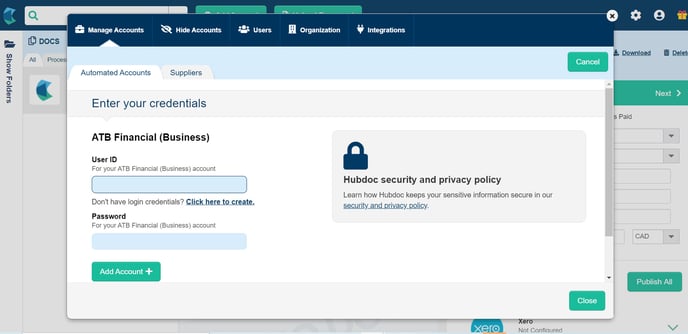Step-by-step instructions for our clients to set up bank statement fetching on Hubdoc
Here is a video walkthrough of setting up a bank account: https://www.loom.com/share/5d020b8eb3c140d78002a1f40dd0ff9f
Step 1: Connect to your accounts
Select the "Add Account" button on the Hubdoc dashboard and use the search bar to find one of your accounts or select one of the popular connections listed. 
Step 2: Enter your credentials
Input the same login credentials used to log in to the selected supplier’s web portal. This allows Hubdoc to log in to the account using read-only access to fetch documents.

Step 3: Add authentication and personal verification questions.
Many financial institutions and other online suppliers may require Personal Verification Questions (PVQs) or Two Factor Authentication (2FA) to verify the login. Hubdoc is able to support these levels of security and will store the information for you. To verify that the login is granted by the account owner, select the "Update Account" button to input all PVQ and 2FA requirements.
Two Factor Authentication (2FA)
This is a security protocol that a number of banks have put in place to bolster security. You will find a "Fix It" button next to the connection within Hubdoc. Select the button to specify a delivery method such as your phone number or email address. In this case, you would input the number (“1”) for your iPhone. A code will be sent to your delivery method of choice, which must be entered in Hubdoc. Once this has been done, Hubdoc will be able to successfully connect and fetch the supplier documents.

Personal Verification Questions (PVQs)
These are questions that only the account owner will know the answers to. This is another layer of security implemented by financial institutions and other online suppliers to flag suspicious logins. Most financial institutions will have anywhere from three to five PVQs associated with an account. All of these will need to be answered through Hubdoc for our system to store the information and help financial institutions recognize Hubdoc as a secured login. Below are steps to cycle through the PVQs when the account is first set up:
1. Add an account and input the login credentials.
2. Once the account has connected, select "Update Accounts" to prompt the first PVQ.

3. Input the answer to the PVQ.

4. Repeat steps 1 to 3 until all PVQs have been successfully answered.
Hubdoc typically asks for a new PVQ each time you log in and our system attempts to fetch documents for you. Cycling through the questions when the account is first set up allows Hubdoc to successfully connect to the account, and avoids the hassle of being prompted to answer a new question each time you log in.
Step 4: Maintain your account
From time to time, you may receive a notification that one of your connections needs attention in order to restore the connection and resume fetching new documents. This could be answering a personal verification question (PVQ) that may not have been prompted before, entering a two-factor authentication code required by the bank, or editing a password that may have been updated on the bank side.
To do this,
1. Log in to Hubdoc.
2. Click "Accounts" in the top right corner.
3. Scroll down to the account that needs attention. If you need to answer a PVQ or enter a two-factor authentication code, there will normally be an error message with a "Fix It" button on the right-hand side. If you would like to edit your login credentials, click "Edit Credentials."

4. Follow the instructions and update the account. Make sure that no additional error messages are prompted to confirm that the connection is successful.
